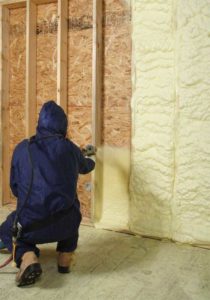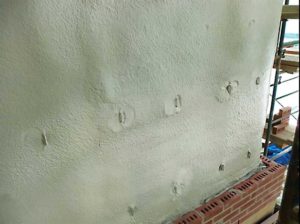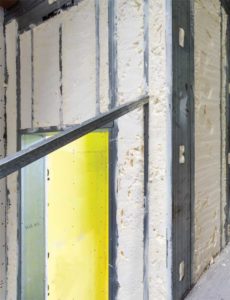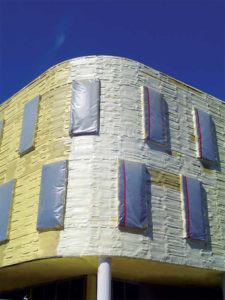Creating air barriers on exterior walls with spray foam
by nithya_caleb | July 13, 2018 8:44 am
 [1]
[1]By John Broniek
When selecting air barrier products to employ in building designs, architects have a broad range of choices. Spray foam insulation products are often selected because they can provide superior performance and also contribute to greater energy and operating cost savings in buildings. In particular, closed-cell (medium-density) and open-cell (low-density) spray applied polyurethane foam (SPF) can insulate and air seal wall assemblies in commercial buildings quite effectively, economically, and efficiently. Their air-sealing characteristics, along with the ability to minimize moisture and temperature-related issues, and capacity to enhance the performance of a wide variety of building types make them ideal for commercial projects. At the same time, more design freedom is realized due to the custom, field-applied nature of the system. As a result, these products are becoming a popular alternative among architects when designing exterior walls for airtight construction.
Background
The need for air barriers in exterior walls is well understood in the building community. Effective air barriers have positive impacts not only on heating and cooling energy costs, but also on moisture problems, indoor air quality (IAQ), and acoustics. This is because moving air can carry unwanted moisture, contaminants, or noise into a building. Overall, proper sealing with an air barrier system results in more sustainable and durable buildings addressing numerous green design issues, such as efficient use of construction resources.
There is a realization among the design community an air barrier system is a combination of components within the building enclosure, which typically includes a primary air barrier material. The system components are designed, installed, and integrated in such a manner as to stop the uncontrolled flow of air into and out of the building enclosure.
Air barrier material performance
In order to qualify as an air barrier material, the air permeance of a product must be equal to or less than
0.02 L/(s·m²) (0.004 cfm/sf) when tested at an air pressure of 75 Pa (1.57 psf). The testing basis for this rating is ASTM E2178, Standard Test Method for Air Permeance of Building Materials. Closed-cell, medium-density, SPF products are required to have this testing conducted to meet the requirements of the Underwriters Laboratories of Canada (CAN/ULC) S705.1-01, Standard for Thermal Insulation–Spray Applied Rigid Polyurethane Foam, Medium Density–Material–Specification.
The National Building Code of Canada (NBC) notes in Appendix A generic, medium- and low-density 25-mm (1-in.) thick polyurethane spray foam products have air permeance characteristics that would result in both qualifying as an air barrier material. Medium-density spray foam insulation is installed at a nominal 32 kg/m³ (2 lb/cf) density while low-density spray foam is installed at a nominal 8 kg/m³
(0.5 lb/cf) density.
 [2]
[2]In the American National Standards Institute/American Society of Heating, Refrigerating and Air-conditioning Engineers/Illuminating Engineering Society of North America (ANSI/ASHRAE/IESNA) 90.1, Energy Standard for Buildings Except Low-rise Residential Buildings, both SPF product types are recognized as air barrier materials. Manufacturers should be consulted for ASTM E2178 test results that indicate the thickness of a specific product for it to qualify as an air barrier material.
Air barrier system performance
The Canadian Construction Materials Centre (CCMC) has developed a Technical Guide for Air Barrier Materials describing the criteria for the assessment of mechanical and physical properties of air barrier systems for exterior walls of low-rise buildings for the purpose of obtaining a CCMC Evaluation Report. Although low- and medium-density SPF products are eligible to apply for a CCMC Air Barrier Systems Report, currently just a small number of medium-density SPF products have obtained it and only for exterior continuous insulation (ci) wall applications.
According to the technical guide, an air barrier system must:
- have an acceptable low air leakage rate;
- be continuous and durable;
- have sufficient strength to resist the anticipated air pressure load; and
- be buildable in the field.
Applications
A significant installation benefit of medium-density spray foam insulation is its ability to conform directly to the wall (sheathing or structural) surface regardless of shape, geometry, or irregularities. It can be employed on the exterior or interior side of a wall and fully covers and seals the underlying construction to provide a continuous, uninterrupted insulation layer. Curved buildings, for example, have traditionally needed a very labour-intensive process where rigid foam boards had be cut to shape and then excessively taped at each joint. This can now be replaced with a quick, smooth, and far less labour-intensive installation of spray foam.
For exterior as well as interior ci applications, medium-density spray foam insulation has several key attributes for wall performance. These include:
- an integral air barrier based on material testing as mentioned earlier in the article;
- high long-term thermal resistance (LTTR) insulation values per CAN/ULC-S770, Standard Test Method for Determination of Long-term Thermal Resistance of Closed-cell Thermal Insulating Foams, testing;
- a vapour barrier, typically at 50-mm (2-in.) thickness or greater, based on water vapour permeance testing per ASTM E96, Standard Test Methods for Water Vapor Transmission of Materials, thereby eliminating the need for a polyethylene (PE) vapour barrier at the inner portion of the wall; and
- a water-resistive barrier (WRB) since it is capable of shedding water (when SPF is integrated with flashings around penetrations and key wall transition points a durable water-resistant system is formed).
 [3]
[3]Air barrier systems
In the CCMC air barrier system evaluations, the medium-density SPF product is considered as the principal material in the plane of airtightness. To qualify as an air barrier system, the wall needs to accommodate movements of building materials, and provide connections to adjacent materials to prevent air leakage at all critical locations including connections, joints, and penetrations. An extensive number of tests are conducted to receive the air barrier system designation.
To achieve air barrier system compliance, it is recognized the use of medium-density, spray foam products in exterior ci wall applications requires membrane materials (self-adhered or liquid) to provide optimum performance. Consequently, a great deal of effort in field evaluations and product compatibility testing has been made by manufacturers to define the components of such a system and where they should be used.
Design and performance considerations
The use of medium-density spray foam insulation in exterior ci applications provides architectural firms and commercial building contractors an opportunity to positively impact their construction schedules, budget, and overall performance quality. Additionally, medium-density spray foam insulation in exterior ci applications offers many benefits including:
- cover the widest range of exposed surfaces to prevent thermal bridging;
- features an approach to air- and water-resistive barrier
(A/WRB) creation not dependent on extensive use of joint sealants in exposed situations; - has a good ability to bond to the entire length of wall penetrations, such as brick ties and fasteners, thereby ensuring thermal and airtightness effectiveness;
- is likely to have air barrier discontinuity at transitions and control joints;
- has very low water absorption and is capable of shedding water; and
- can be applied in cold temperatures as low as -10 C (14 F).
There can be challenges associated with SPF exterior ci, but most of them can be overcome with attention to details and pre-application planning. Dry and non-windy weather conditions are necessary to facilitate optimal product adhesion and limit over-spray situations. The application area should be isolated and other construction trades restricted from entering. One should confirm the substrates the spray foam will be applied to are compatible with it. A plan must be developed to ensure wall penetrations, including windows, doors, anchors, and attachments, are covered or will be remediated so the spray foam does not affect their long-term operation.
 [4]
[4]Using open-cell, low-density spray foam insulation
Although it has most often been associated with residential construction, low-density spray foam can also be employed on the interior side of a commercial building. Its air-sealing characteristics allow it to qualify as an air barrier material. Many spray foam manufacturers have the appropriate test information to confirm that ability. Therefore, using open-cell spray foam within a wall cavity, with either metal or wood studs, can constitute the main component of an air barrier system. Its use also means expensive air membranes on the exterior of the wall sheathing can be avoided or scaled back in scope, thereby reducing construction costs. Open-cell spray foam can be sprayed on cold substrates, and therefore can be employed in cold weather applications. It can be used for applications on wood-based substrates. It is also compatible with concrete, masonry, and steel. Open-cell spray foam can be cut fairly easily allowing for changes, such as adding an electrical box within a wall stud cavity, to occur more simply.
Open-cell spray foam insulation effectively blocks heat transfer with a tested thermal performance of approximately 0.66 to 0.72 (m2•K)/W (R-3.7 to R-4 per in.). Its lower density gives it a comparatively softer make-up than denser, closed-cell insulation, meaning it can also seal around the edges and perimeter of stud cavities and any penetrations in a flexible manner. Some of the other benefits of open-cell insulation are tied to this lighter, softer, and more flexible make-up. Acoustic control, for example, is enhanced in wall assemblies due to its flexible and absorptive properties, more so than with rigid insulation. Should water infiltrate the assembly for any reason, its vapour permeability means the material can dry both toward the interior and the exterior as may be preferred. As a material, it does not provide a food source for mould. The cost of open-cell spray foam insulation is generally very attractive and competitive when compared to labour and materials for other types of insulations.
Installing spray foam insulation within building interior assemblies is typically less challenging than exterior applications. Isolating the application area and having the substrates ready for spraying are still necessary. Further, the building construction should be far along so the installed SPF will not be subject to weather. If windows are not in place it is good practice to cover their openings.
As with all construction products, installation is critical to the performance of the material and development of a high performing wall air barrier. Spray foam installers who have successfully undergone training at the hands of manufacturers or a trade association are more likely to deliver the installation needed. Specifically, the Canadian Urethane Foam Contractors Association (CUFCA) has an installer certification process including training and licensing.
The advantages of using spray foam insulation to create an air barrier on exterior walls are numerous. Using medium-density SPF products in an exterior ci wall application has been proven to create an airtight assembly, and is becoming widely specified. Meanwhile, low-density SPF products are a cost-effective approach to creating airtightness within wall stud cavities. In both cases, the result is a more energy efficient building.
![]() [5]John Broniek is senior engineer for Icynene-Lapolla where he provides product use recommendations to all external audiences including designers, applicators, and building owners. He also acts as a building science technical resource to Icynene-Lapolla’s sales team and dealers. Broniek has been involved in improving the energy efficiency and durability of buildings throughout North America since 1990. He can be reached via e-mail at jbroniek@icynene-lapolla.com[6].
[5]John Broniek is senior engineer for Icynene-Lapolla where he provides product use recommendations to all external audiences including designers, applicators, and building owners. He also acts as a building science technical resource to Icynene-Lapolla’s sales team and dealers. Broniek has been involved in improving the energy efficiency and durability of buildings throughout North America since 1990. He can be reached via e-mail at jbroniek@icynene-lapolla.com[6].
- [Image]: https://www.constructioncanada.net/wp-content/uploads/2018/07/Icynene5.jpg
- [Image]: https://www.constructioncanada.net/wp-content/uploads/2018/07/icynene-exterior-wall.jpg
- [Image]: https://www.constructioncanada.net/wp-content/uploads/2018/07/Icynene-walls.jpg
- [Image]: https://www.constructioncanada.net/wp-content/uploads/2018/07/icynene-design.jpg
- [Image]: https://www.constructioncanada.net/wp-content/uploads/2018/07/John-Broniek.jpg
- jbroniek@icynene-lapolla.com: mailto:jbroniek@icynene-lapolla.com
Source URL: https://www.constructioncanada.net/creating-air-barriers-on-exterior-walls-with-spray-foam/